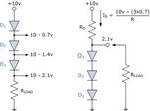Half Awake
Newbie level 4
Hello
I need a charger to charge 3 lead acid (AGM) batteries in series. I finally settled on this one through lack of choice despite it not having the connector I needed (it is simple enough to change). **broken link removed**
I measured its output voltages and it seems to be a bit higher than what is good for an AGM. This is something I have noticed as most battery manufacturers state voltages that should used to charge which are much lower than what the chargers supply. In this ones case it float charges at 13.9v. I know it is done because it makes them charge faster. I think this is a problem as AGM are more sensitive to being overvolted and can suffer as a result normally due to loss of surface area as bubbles building up on the plates through guassing (I think it is called). I would rather charge them at a slightly lower voltage. I don't mind waiting longer for it to charge.
Would it be advisable to place a diode in series with the 3 stage charger linked above to slightly lower its voltage without affecting its ability to function?
Also what is the name of the connector it uses, it looks a bit like an audio connection called RCA but it is bigger? I have searched for over an hour with no luck.
Thank you
I need a charger to charge 3 lead acid (AGM) batteries in series. I finally settled on this one through lack of choice despite it not having the connector I needed (it is simple enough to change). **broken link removed**
I measured its output voltages and it seems to be a bit higher than what is good for an AGM. This is something I have noticed as most battery manufacturers state voltages that should used to charge which are much lower than what the chargers supply. In this ones case it float charges at 13.9v. I know it is done because it makes them charge faster. I think this is a problem as AGM are more sensitive to being overvolted and can suffer as a result normally due to loss of surface area as bubbles building up on the plates through guassing (I think it is called). I would rather charge them at a slightly lower voltage. I don't mind waiting longer for it to charge.
Would it be advisable to place a diode in series with the 3 stage charger linked above to slightly lower its voltage without affecting its ability to function?
Also what is the name of the connector it uses, it looks a bit like an audio connection called RCA but it is bigger? I have searched for over an hour with no luck.
Thank you
